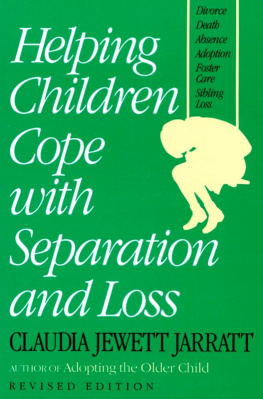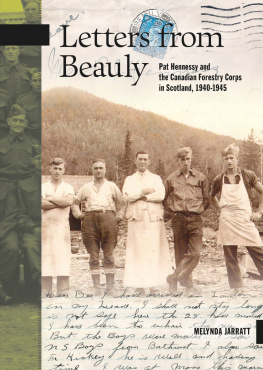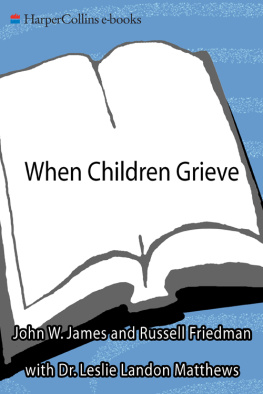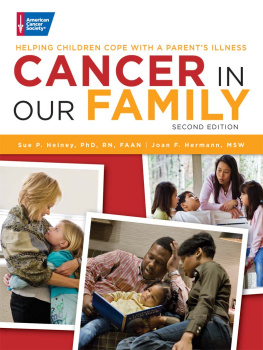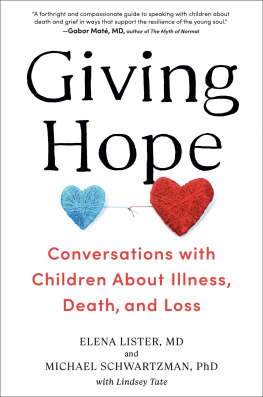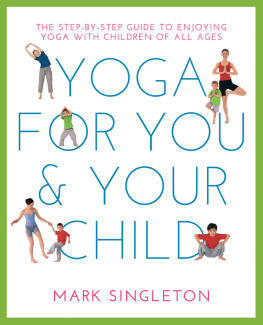Jarratt - Helping Children Cope with Separation and Loss
Here you can read online Jarratt - Helping Children Cope with Separation and Loss full text of the book (entire story) in english for free. Download pdf and epub, get meaning, cover and reviews about this ebook. City: Boston;Mass, year: 1994, publisher: Harvard Common Press, genre: Children. Description of the work, (preface) as well as reviews are available. Best literature library LitArk.com created for fans of good reading and offers a wide selection of genres:
Romance novel
Science fiction
Adventure
Detective
Science
History
Home and family
Prose
Art
Politics
Computer
Non-fiction
Religion
Business
Children
Humor
Choose a favorite category and find really read worthwhile books. Enjoy immersion in the world of imagination, feel the emotions of the characters or learn something new for yourself, make an fascinating discovery.
- Book:Helping Children Cope with Separation and Loss
- Author:
- Publisher:Harvard Common Press
- Genre:
- Year:1994
- City:Boston;Mass
- Rating:4 / 5
- Favourites:Add to favourites
- Your mark:
- 80
- 1
- 2
- 3
- 4
- 5
Helping Children Cope with Separation and Loss: summary, description and annotation
We offer to read an annotation, description, summary or preface (depends on what the author of the book "Helping Children Cope with Separation and Loss" wrote himself). If you haven't found the necessary information about the book — write in the comments, we will try to find it.
A compassionate, step-by-step guide to help children cope with and recover from any kind of loss.
Jarratt: author's other books
Who wrote Helping Children Cope with Separation and Loss? Find out the surname, the name of the author of the book and a list of all author's works by series.
Helping Children Cope with Separation and Loss — read online for free the complete book (whole text) full work
Below is the text of the book, divided by pages. System saving the place of the last page read, allows you to conveniently read the book "Helping Children Cope with Separation and Loss" online for free, without having to search again every time where you left off. Put a bookmark, and you can go to the page where you finished reading at any time.
Font size:
Interval:
Bookmark:
To the Giver of Health,
who provides for the return
of love, hope, joy, and meaning;
to Fran, whose dying began it all;
and to Bob, just because.
The Harvard Common Press
535 Albany Street
Boston, Massachusetts 02118
Copyright 1982, 1994 by The Harvard Common Press
All rights reserved. No part of this publication may be reproduced
or transmitted in any form or by any means, electronic or me
chanical, including photocopy, recording, or any information
storage or retrieval system, without permission in writing from
the publisher.
Printed in the United States of America.
Library of Congress Cataloging in Publication Data
Jarratt, Claudia Jewett, 1939
Helping children cope with separation and loss / Claudia
Jewett Jarratt.[Rev. ed.]
p. cm.
Includes bibliographical references and index.
ISBN 1-55832-052-0 (cloth).ISBN 1-55832-051-2 (paper).
1. Grief in children. 2. Separation (Psychology) in
children. 3. Loss (Psychology) in children. 4. Children
Counseling of.
I. Title.
BF723.G75J48 1994
155.9'37'083dc20 93-33178
CIP
Interior design by Joyce C. Weston
Cover design by Paul Bacon
10 9 8 7 6 5 4
Any adult who is involved with children, whether caregiver or professional, may need at some point to help a grieving child. Census statistics document that over a quarter of all children in this country under the age of eighteen live with only one of their parents (Rawlings 1993). Almost every child will experience the death of a significant otherpet, friend, or relative. In an average-size school, a child will die about every three to four years, affecting the lives of the child's friends, schoolmates, teachers, and family (Linn 1980, 13).
Parents are particularly likely to be anxious when their children experience separation and loss, especially if they themselves are devastated by grief and pain. At school, teachers and other personnel must find ways to cope with children whose behavior and performance suffer drastic changes following loss. Doctors and nurses need to be alert to the physiological connections between grief and physical changes such as hyperactivity, serious lethargy, increased susceptibility to colds and flu. Therapists, ministers, social workers, and other counselors all need techniques to help children understand and accept what has happened as well as to guide caregivers as to how best to respond appropriately to grieving children. Close neighbors, relatives, or friends of the family often want to help; they, too, need to understand better how to support a child during a time of grief.
Children's immediate reactions to loss and their responses to the challenges that follow it are striking: fears for personal survival;
separation anxiety; impaired ability to make emotional attachments; sadness, anger, guilt, shame, depression, and despair; problems with control issues; diminished developmental energy; loss of self-esteem; ongoing pessimism and feelings of futility are all normal in grieving children. Many believe that childhood bereavement and the consequent changes within children and their social and familial circles can create severe emotional and behavioral challenges that last well into adult life. Growing evidence links childhood loss with depression, alcoholism, anxiety, and suicidal tendencies in adolescence and adulthood.
Clearly, adults who care about children can benefit from learning how to recognize and work with grief. But partly because of the paucity of training in grief work with children, even professionals may not understand that much of the difficult behavior the child displays can be directly connected to grief or that appropriate support can help the child replace troubling behaviors with more constructive expressions of inner turmoil. Many children are denied help after a loss because those around them discount the severity of its effect on them. Or they receive help only at the beginning of the grief process, leaving them to meet the subsequent challenges alone. Sometimes children themselves are reluctant to talk to their caregivers about a shared loss for fear of creating more pain. It is no wonder that children are sometimes called "the forgotten mourners."
Even when a child is given good support over a long period of time, it appears that losses and separations may leave vulnerabilities that can be retriggered by new developmental tasks, new relationships or achievements, or any of the changes that come to people in the course of their lives. Loss is a cumulative experience; unless the child is helped to resolve a major loss, even trivial subsequent losses are likely to provoke intense stresses and reactions. Still, research finds that children who are given high-quality care by available family members during the mourning period or who are effectively helped by alternate caregivers or other helpers experience less distress and perhaps fewer long-lasting repercussions (Garmezy 1983).
Until the first edition of this book, there were almost no guidelines to follow nor methods advanced as to how to help children manage grief constructively. This book presents practical advice for those concerned with helping children through the recovery process. It identifies specific behaviors one can expect in a child who has suffered a loss, showing when and how these behaviors may arise, discussing those that may immediately follow a loss and those that may appear or recur years later, and offering clear suggestions on how concerned adults might best respond. The original techniques and descriptions of simple props that were the mainstay of the first edition of this book have been expanded as an outgrowth of my continuing work as a child and family therapist. The theoretical underpinnings that helped previous readers clarify what to look for and how to respond have been refined and enlarged as well. Parents, primary caregivers, and other helping adultstherapists, school counselors, teachers, day-care providers, doctors, nurses, ministers, friends, or relativeswill find plentiful descriptions of practical methods for helping children through the strong feelings, difficult behavior, and confusion that follow a loss.
Because the first problem is usually how to tell the child about the loss, the book begins with a general discussion of how to convey the news and support the child, followed by a chapter offering suggestions on how to tell children about specific losses. The next chapter traces the normal progression of grief, and chapters 4 and 5 discuss ways to help children who appear stuck at various points in the grief process to work through their problems. The final chapter deals with letting go and moving on. Examples and dialogues taken from a wide variety of situations are used to demonstrate how children can be supported as they weather the challenges and stress of acute grief, move through the subsequent adjustments and reactions, and become more able to get on with a healthy, functional life.
We assume a crucial task when we seek to help mourning children. Our success depends on our willingness to offer support during a troubled and baffling time. The methods this book describes can make this task clearer and easier. The challenge is great, but the rewards are greater, for these methods offer the promise of health and full, rich lives for the children you know and care about.
Greg has spent summers with his grandma and grandpa since he was quite young. He and his grandpa have always been very close, sharing jokes, rooting for rival baseball teams, and going fishing together as often as possible. Just as school is ending for the year, Greg's grandfather dies of a sudden heart attack. Greg must be told. His stricken parents not only must help their son come to grips with the death of his beloved grandfather but must also deal with the funeral arrangements and quickly make other plans for the summer.
Next pageFont size:
Interval:
Bookmark:
Similar books «Helping Children Cope with Separation and Loss»
Look at similar books to Helping Children Cope with Separation and Loss. We have selected literature similar in name and meaning in the hope of providing readers with more options to find new, interesting, not yet read works.
Discussion, reviews of the book Helping Children Cope with Separation and Loss and just readers' own opinions. Leave your comments, write what you think about the work, its meaning or the main characters. Specify what exactly you liked and what you didn't like, and why you think so.

